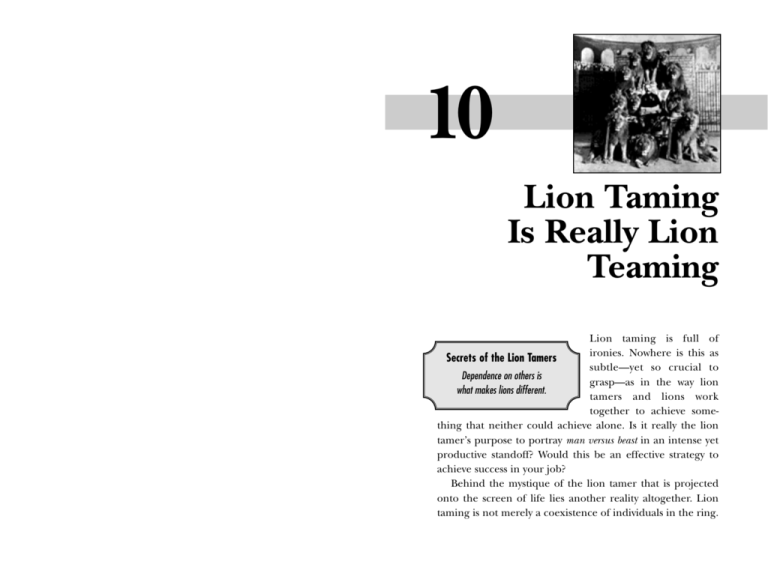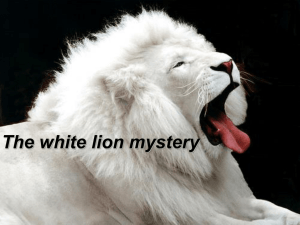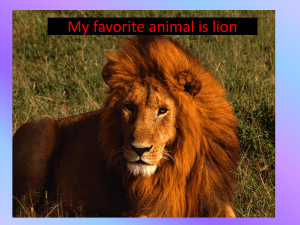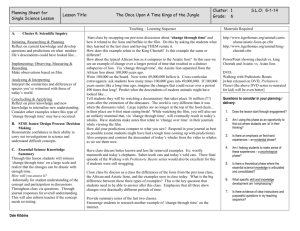Lion Taming Is Really Lion Teaming
advertisement

10 Lion Taming Is Really Lion Teaming Lion taming is full of ironies. Nowhere is this as Secrets of the Lion Tamers subtle—yet so crucial to Dependence on others is grasp—as in the way lion what makes lions different. tamers and lions work together to achieve something that neither could achieve alone. Is it really the lion tamer’s purpose to portray man versus beast in an intense yet productive standoff? Would this be an effective strategy to achieve success in your job? Behind the mystique of the lion tamer that is projected onto the screen of life lies another reality altogether. Lion taming is not merely a coexistence of individuals in the ring. 192 ✦ LION TAMING What is the secret? It is the golden nugget of lion-taming wisdom. Lion taming is really lion teaming! It is the basis for the one-to-one relationship between the lion tamer and each of the lions. At the same time, it is the concept that connects the lions and everyone that surrounds them in the larger environment. While taking quite seriously the matter of establishing his or her own presence, credibility, and reputation with the lions, the lion tamer works with a positive attitude to foster rapport, trust, and mutual respect. Behind every performance are hours of long training and a sorting of roles between the lion tamer and the lion, and also others around them. It is the building of the lion team. The same ironies that underlie the difference between Secrets of the Lion Tamers mystique and reality in real When lions leap through hoops lion taming also exist in the of fire, they don’t want it to look office environment, and like someone made them do it. make it equally important to consider how lion teaming applies to your job. Step back and consider your own experiences. Where do new ideas come from? How are problems identified and solutions developed? Who identifies the strengths and talent needed to achieve objectives? What is the role of the lions and how do others play a part? Is there a time when everyone checks their titles and expertise at the door in order to put their minds together, after which they don their titles, talents, and capabilities to implement and perform? Lion Taming Is Really Lion Teaming ✦ 193 Four kinds of hoops of fire—leadership, management, communications, and relationships—are good examples, and you may have others to add to the list. Leadership Leadership hoops of fire include: • Creating momentum and energy • Providing vision • Achieving goals • Making crucial decisions, large and small, that enable others to do their jobs Management Management hoops of fire include: • Hiring and firing the right people • Handling a crisis effectively • Addressing specific needs related to operations, people, policy, markets, finance, or technology Communications Hoops of Fire The purpose of any team is to work toward a set of goals— hoops of fire, you might say. Executives, bosses, clients, and customers need to jump through hoops of fire. These are not only identifiable goals, but often the very reasons that bring people in contact with the lions that they work with every day. Relationship Communications hoops of fire include: • Developing the right message • Saying it to the right people at the right time • Connecting to a larger public • Setting expectations • Satisfying the need for accuracy, accountability, and transparency Relationship hoops of fire include: • Maintaining old relationships • Establishing new relationships • Clarifying relationships and status 194 ✦ LION TAMING The hoops of fire may also be related to short-term decision making, direction setting, policy-making resource allocation, or delegation of authority—the hoops of fire that are always visible when you think of the reasons why you are walking into the boss’s office. How does it all get accomplished? The same persistent irony that lion tamers must confront in the steel-caged arena exists in the office. Despite the appearance of strength and self-sufficiency—not to mention the scary glances and offputting indifference to others—lions in the office can and will work with others to see goals, develop the process for reaching the goals, and execute individually and as part of a team. However, never forget that they are still lions. As one observer noted, “When lions leap through hoops of fire, they don’t want it to look like someone made them do it!” A Place in the Pride There is another nugget of lion-taming wisdom that Secrets of the Lion Tamers explains how and why the Many things are not what they seem. lions in the wild and in the office can team with others individually and as part of larger group. It is that lions are hardwired to be dominant, but they are also hardwired as “pride” animals. Lions in the wild and in the workplace are social animals, and to survive as lions they must operate in two parallel worlds—the hierarchy and the pride or group. There are specific qualities to their lives in both the social hierarchy and social groups or organizations that reflect how the lions in the wild and in the workplace are hardwired for teaming. In the workplace, on the one hand that translates into the power structure of titles, rank, and position. On the other hand, it means the surrounding worlds of nations, communities, companies, organizations, groups, networks, and the Lion Taming Is Really Lion Teaming ✦ 195 individuals in society that give meaning, purpose, and support to the lion’s place in the hierarchy. After all, social dominance is meaningless without social context. These worlds are not merely complementary; they are necessary to the lion’s survival. As part of a group, even the leader has a specific and useful role that has countervailing limitations. There are things that lions cannot do no matter how powerful they are. Hierarchy and the existence of a larger group work together as a catalyst for important roles and responsibilities for everyone, including the lion. Most people don’t consider the role they could play in teaming with their boss, or consider whether their boss has everything he or she needs to get the job done. When lions enter the arena, everyone’s attention is focused on the lion’s every breath, move, and look! It’s true whether it is a CEO at the podium, a school principal addressing an assembly, or a foreman on the production line. We don’t figure that they need the help of others, and most would not advertise it. Yet all good performances begin behind the scenes, working together and in a disciplined manner to learn, train, and prepare. Why do we have a tendency to assume that the lions in the workplace do not need to team? Simply put, we are convinced by their image of dominance that they can take on all comers and need no one. Sometimes we want to be convinced of this because we want our lions to be strong, charismatic, and ready to pounce. The imagery and the visible battles for position and status convince us. As a result, the lion’s mystique continues to rule the day. We mistake the lion’s image in the hierarchy for his or her specific purpose and role. However, in almost all cases, the functional purpose and abilities of the lions in the workplace are far less defined than their status or title, and that is in part why they need others around them. 208 ✦ LION TAMING Lion Taming Is Really Lion Teaming ✦ 209 THE LION’S TALE • To ensure their survival and success, leaders, bosses, and other lions create their own territory, social order, resources, and networks of movements and relationships. • Observe the lion’s world, territory, and domain to view the workplace through the lion’s eyes. • The presence of a lion can have unintended consequences. If the boss’s presence becomes too pervasive, nothing will get done. • The lion’s inherent limitation of movement and relationships creates a need, a role, and responsibilities for others that can move more freely. • You can operate in the lion’s world, but the lion cannot always operate in yours. Use that reality in ways that are constructive, supportive, and beneficial to the lion so that they can perform their own job. • People in power need other people who have more freedom of movement because they are less conspicuous than “the boss” to be participant-observers inside and outside the organization, represent them, be diplomats, and bring others closer to them.









